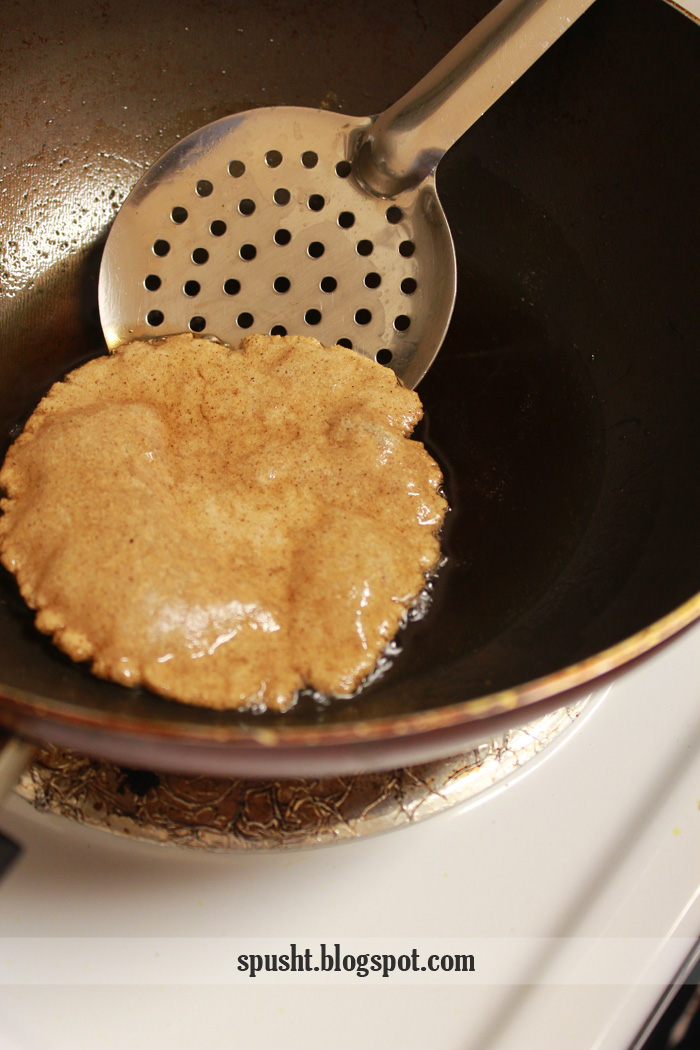When my mother-in-law visited us few months back, it was imperative she cook and teach me these two amazing dishes. In this post I’m sharing my mother-in-law’s remarkable and simple recipes for a delightful Singhare ki Puri and mouthwatering Arbi ki Sabji.
Singhara is known as water caltrop or water chestnut in English. It’s not the round, white colored chestnut that’s popularly used in Chinese cuisine. Singhara is a fruit, a pale white colored triangle shaped encase in a black colored peel. Singhara is very nutritional, can be eaten raw, boiled, or dried and ground into a flour. Also, singhaare ka aata can be used to make Singhare ke Pakode (appetizer), Singhaare ki Puri (main course), and Singhare ka Seera (dessert) – awesome, eh?! People who observe a religious fasting and cannot eat all kinds of flours can incorporate the water chestnut flour (singhare ka aata) in their meal. If you are not cooking these dishes for fasting, you can use regular table salt instead of rock salt.
Singhare ki Puri Recipe
My mother-in-law’s recipe
Serves about 4
¾ cup singhare ka aata, plus some for rolling
½ tsp rock salt
½ cup arbi, boiled & mashed
Ghee for deep frying
Make 10 balls and flatten them. If you want to make smaller puri you can divide into 12 balls.
Meanwhile heat ghee in a frying pan. With the help of extra singhare ka aata, roll out the dough balls into a small round puri about 4 inches in diameter.
Once the ghee is hot for frying, carefully lift up the rolled puri and deep fry in hot ghee on both sides and allow it to puff up, just like you would fry kadhai ki puri. Done.
. . . . . . . . . . . . . . . . . . . . . . . . . . . . . . . . . . . . . . . . . . . . . . . . . . . . . . . . . . . . . . . . . . . . . . . . . . . . . . . .
Arbi also called as Arvi, is known as eddo/taro/colocasia in English. It is a tropical root vegetable, starchy like potato, is hairy and weird-looking on the outside but once boiled and peeled and cooked it turns into this delicious goodness.
While many people cook dry version of arbi or in a yogurt gravy to eat with a regular roti, or a potato curry to eat with singhare ki poori, this really easy and quick jholwali / rassedaar (broth-like) arbi ki sabji that my mother-in-law makes with singhare ki poori is like a match made in heaven.
Jholwali / Rassedaar Arbi ki Sabzi Recipe
My mother-in-law’s recipe
Serves about 4
1 big arbi
2 potatoes
1 tsp ghee
½ tsp chopped green chilies
1 tsp black pepper powder
1 tsp rock salt
Pressure cook arbi + potatoes on medium heat until 1 whistle or boil in a pan. Drain the water and let them cool down then peel them. Both the arbi + potatoes mashed together should equal about 1 cup total.
Heat ghee in a pan on medium heat. Add green chilies + black pepper powder. Add the 1 cup mashed arbi + potatoes and mix. Add 1 cup water + rock salt. Cook until the water comes to a rolling boil. Done.
Unlike Kadhai ki Puri that you can fry ahead of time and eat even the next day, singhare ki poori is BEST SERVED AND EATEN HOT. So reserve the kneading (it won't take too long), rolling, and frying only when you are ready to eat.
This rassedaar arbi ki sabzi with such minimum ingredients goes well with even kadhai ki poori or rice. The black pepper powder in this recipe gives it this wonderful aroma, spice, and flavor.
I hope you will love these two recipes as much as I do. If you cook these dishes, let me know in the comments below or even better - post a picture on Spusht's Facebook Page or email me.
Enjoy.
. . . . . . . . . . . . . . . . . . . . . . . .
Come connect with me! on Facebook | Email | RSS | Twitter









